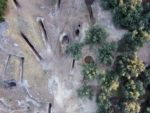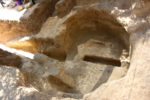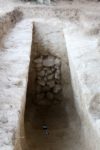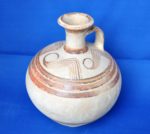 Two intact Bronze Age tombs have been discovered in Aidonia cemetery near Nemea in Greece’s Peloponnese peninsula. Both chamber tombs date to the late Mycenaean period (1400-1200 B.C.) and were found complete with human remains and grave goods.
Two intact Bronze Age tombs have been discovered in Aidonia cemetery near Nemea in Greece’s Peloponnese peninsula. Both chamber tombs date to the late Mycenaean period (1400-1200 B.C.) and were found complete with human remains and grave goods.
 The Aidonia cemetery contains rock-cut chamber graves dating to the Mycenaean era (17th-12th century B.C.). They are of consistent design, each made of three sections: a road or pathway leading to an entrance leading to the burial chamber. The early Mycenaean tombs held richer and more extensive grave goods — jewelry, gold, weapons, luxury ceramics — while the late period chambers had more modest offerings. The newly-discovered tombs contained mainly pottery — figurines, clay vessels, false amphorae, basins — and smaller objects like buttons.
The Aidonia cemetery contains rock-cut chamber graves dating to the Mycenaean era (17th-12th century B.C.). They are of consistent design, each made of three sections: a road or pathway leading to an entrance leading to the burial chamber. The early Mycenaean tombs held richer and more extensive grave goods — jewelry, gold, weapons, luxury ceramics — while the late period chambers had more modest offerings. The newly-discovered tombs contained mainly pottery — figurines, clay vessels, false amphorae, basins — and smaller objects like buttons.
 The tombs were reused over the centuries, with the primary (original) burials followed by secondary ones. One of the newly-discovered tombs contained two primary burials and 14 secondary ones. The other tomb contained three primary burials only and was not reused due to the entrance having been blocked by the collapse of the roof soon after its construction. As with the older intact tomb discovered last year, that collapse kept it from being reused and thousands of year later saved it from looters by sealing off and obscuring the entrance.
The tombs were reused over the centuries, with the primary (original) burials followed by secondary ones. One of the newly-discovered tombs contained two primary burials and 14 secondary ones. The other tomb contained three primary burials only and was not reused due to the entrance having been blocked by the collapse of the roof soon after its construction. As with the older intact tomb discovered last year, that collapse kept it from being reused and thousands of year later saved it from looters by sealing off and obscuring the entrance.
 The Mycenaean-era cemetery was discovered not by archaeologists but by looters in 1976. They plundered its ancient grave goods with shameless brutality for two years, with rival tomb raiders getting into literal shootouts at the site until the country put armed guards on the site in 1978 and the first official excavation began. The 1978-1980 and 1986 excavations unearthed 20 tombs, 18 of which had been looted.
The Mycenaean-era cemetery was discovered not by archaeologists but by looters in 1976. They plundered its ancient grave goods with shameless brutality for two years, with rival tomb raiders getting into literal shootouts at the site until the country put armed guards on the site in 1978 and the first official excavation began. The 1978-1980 and 1986 excavations unearthed 20 tombs, 18 of which had been looted.
 While the pitched battles and overt despoiling of the cemetery ended when the government took over, the looting never did entirely stop. In 2016, the Corinthian Ephorate of Antiquities launched a new excavation program by an international team of researchers to systematically explore the site. The team discovered a new cluster of tombs, most of which had been pillaged, likely in the early 2000s.
While the pitched battles and overt despoiling of the cemetery ended when the government took over, the looting never did entirely stop. In 2016, the Corinthian Ephorate of Antiquities launched a new excavation program by an international team of researchers to systematically explore the site. The team discovered a new cluster of tombs, most of which had been pillaged, likely in the early 2000s.